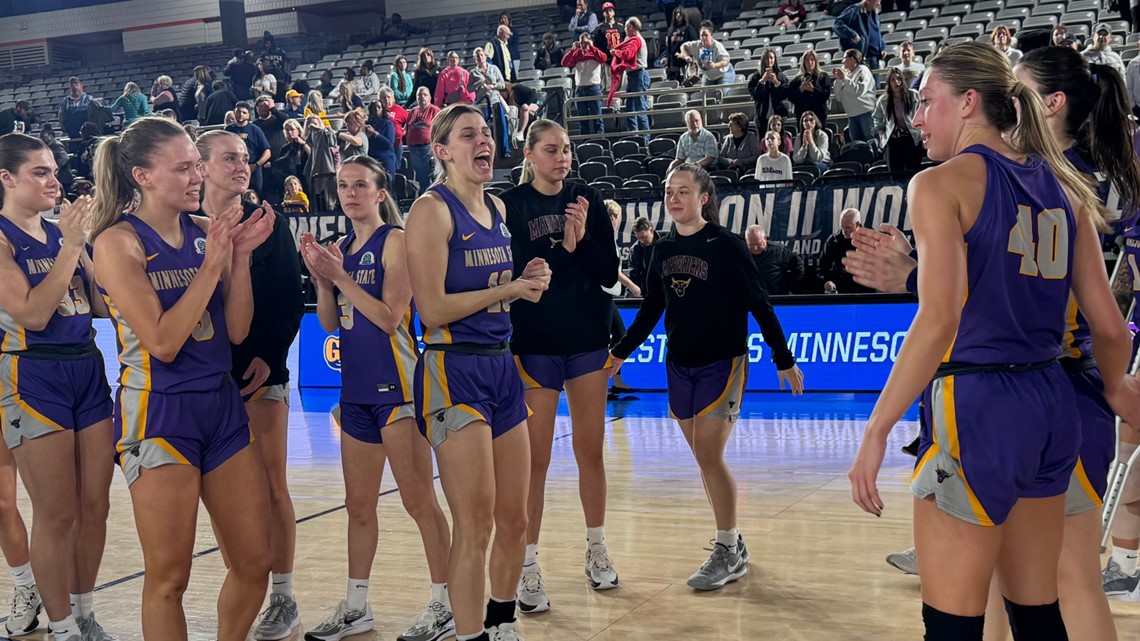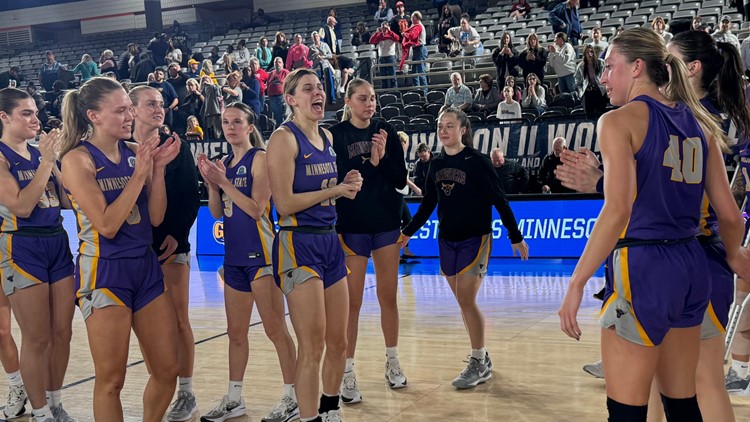Kare11
Minnesota State edges claims both D-II championships


Minnesota State (35-2) became just the third school in any division to win both the men’s and women’s championships in the same season.
EVANSVILLE, Ind — Kyrese Willingham buried a 3-pointer with a second remaining and Minnesota State beat Nova Southeastern 88-85 to win its first Division II championship at the Ford Center on Saturday.
Minnesota State (35-2) became just the third school in any division to win both the men’s and women’s championships in the same season. The women beat Texas Women’s University 89-73 on Friday. Connecticut accomplished the feat twice at the Division I level, doing so in 2004 and 2014. Central Missouri State won both D-II titles in 1984.
Willingham’s winning shot came after the Mavericks blew a 13-point lead in the final 10 minutes.
Dylan Peeters had 19 points on 9-for-10 shooting to lead the Mavericks, who won their final 16 games of the season. Justin Eagins totaled 17 points and six rebounds. Kyreese and older brother Malik Willingham as well as reserve Harrison Braudis each scored 12. Kyreese added five rebounds and three steals, while Malik finished with five assists and five steals. Elijah Hazekamp pitched in with nine points and eight rebounds.
MJ Iraldi scored 19 of his game-high 25 points in the second half for defending-champion Nova Southeastern (32-3), which won its first championship last season with a 111-101 victory over West Liberty. Shane Hunter totaled 19 points and 10 rebounds. Isaiah Fuller scored 12 and Ryker Cisarik added 11 points and six rebounds. The loss snapped a 20-game win streak for the Sharks.
Iraldi and Fuller had three-point plays as Nova Southeastern jumped out to 12-2 lead. Minnesota State battled back and two straight baskets from Kyreese Willingham and Peeters turned a 19-9 deficit into a 26-25 lead for the Mavericks with 7:10 remaining in the first half.
There were seven lead changes and three ties from there until Trey Doomes hit a turnaround jumper in the paint to give the Sharks a 40-38 advantage at halftime.
Minnesota State came out firing in the second half, using 3-pointers from Hazekamp and Eagins to forge a 10-0 run that took 76 seconds. Another Hazekamp 3-pointer gave the Mavericks their biggest lead at 56-43 with 16:43 remaining.
Iraldi and Hunter had two baskets apiece in a 13-0 run and the Sharks pulled even at 71 with 6:55 to go. A Malik Willingham layup off a steal by his brother ended the run but another Iraldi layup knotted the score. Peeters scored for the Mavericks, but Iraldi answered with a 3-pointer and the Sharks took their first lead of the second half 76-75 with 4:50 left.
Nova Southeastern took its last lead at 81-80 on an Iraldi 3-pointer with 2:37 remaining. Eagins hit a 3-pointer and Kyreese Willingham had a layup off a steal and assist from his brother and Minnesota State led 85-81. Hunter and Iraldi had back-to-back layups to tie the game with 1:15 to go.
Watch the latest reports from the KARE 11 sports team in our YouTube playlist:
Kare11
Minneapolis City Council proposes resolution to close the HERC


Ever since 1989, when the Hennepin County Recovery Center (HERC) first opened, people have protested against it.
MINNEAPOLIS — Ever since 1989, when the Hennepin Energy Recovery Center (HERC) first opened, people have protested against it. On Thursday that fight continued.
The Minneapolis City Council proposed a resolution that calls for a closure date of the HERC sooner rather than later.
Concerned residents sounded off at the meeting on the North Loop trash incinerator that burns roughly 365 thousand tons of garbage a year.
“The HERC is terrible for public health, it’s also bad for the climate,” a concerned resident said.
In October 2023, the Hennepin County Board signed off on a plan to close the HERC between 2028 and 2040, depending on how quickly the county can transition into a zero-waste system. Those opposed want it closed by the end of 2025.
“The solution to resolving these risks is to close HERC as soon as possible and strongly commit to reducing reusing and recycling waste,” a concerned resident said.
Of the garbage burned at the HERC, 75% comes from the city of Minneapolis. The other 25% comes from a dozen other cities in the area. The HERC produces enough energy to power more than 25,000 homes and half the buildings in downtown Minneapolis.
At Thursday’s City Council Meeting, Jenni Lansing with the City of Minneapolis Health Department provided analysis on the air pollution impacts of HERC. She said the health department supports working towards a zero-waste future and the ultimate closure of HERC, but said closing it now is not the solution.
“Overall emissions in Hennepin County are dominated by on-road and non-road, mobile and nonpoint sources, and these sources drive the cancer and non-cancer risks to health in Minneapolis,” Lansing said.
According to the Minnesota Pollution Control Agency, the HERC contributes to 0.24% of all Hennepin County emissions, and the risk of someone developing cancer from the HERC is 1 in 100,000. For context four in 10 people in Minnesota will have cancer in their lifetime showing the risk for cancer is minimal according to these stats.
“The premature closure of HERC will result in increased truck transportation of trash throughout the county and outside of Hennepin County to landfills, resulting in more than 10,000 additional trips by semi-trailer trucks,” Lansing said.
This increase in semi-trailer traffic to landfills, Lansing said, would be a much greater contributor to cancer and air pollution in Minneapolis than the HERC is.
Hennepin County defines zero waste as preventing 90% or more of all discarded materials from being landfilled or incinerated. A final vote on the resolution is expected on October 31.
Kare11
MN high school hosts 75th high school reunion


There are around 60 living members of the class of 1949.
MINNEAPOLIS — Did you go to your 20-year high school reunion? 50th? How about 75th?
We can all hope to be so lucky, right?
At Thomas Edison High School in North East Minneapolis, a handful of students were so lucky Thursday, 75 years after graduation. About 20 alumni showed up to the reunion gathering.
“We believe we have 60 living members,” said Dick Anderson, who organized the event. “We have a lot of good people.”
That’s part of the reason why the group of 92 and 93-year-olds look back so fondly on their time.
Pat Hennen Myklebust remembers her first day of school, and worried about making friends. She wasn’t as outgoing in 1949.
“They were warm,” she said. “You felt like you belonged.”
Still, her recollection is fading.
“There’s a gentleman when I came in, he, he was my prom date,” she said. “And I thought, and I can’t even remember, but I’m 93 and there’s a lot of things that I don’t remember.”
She wishes she had written more memories down. Her classmate, Lowell Ludford did.
“There was the lunchroom food fights.” said Ludford. “A memorable one occurred when Stuart Lease threw a blob of chocolate pudding at me.”
But not all high school experiences were so cheery.
Betty Boeser Silbernagel didn’t go to games or join any clubs.
“We were so poor,” she said. “I was the eldest of 10 kids and we had nothing.”
But despite that, she says this school made her into the woman she is today.
“The lord’s been good to me now,” she said.
So she’ll cling to those memories, and everything high school Betty endured.
Kare11
Twin Cities have finished removing infected ash trees


The emerald ash borer is a beetle discovered in the Twin Cities around 2009 that attacks and kills ash trees.
MINNEAPOLIS — For the past 15 years, the Twin Cities have had a message about their ash trees – beware of the emerald ash borer.
The invasive beetle was discovered in the area around 2009 and attacks and kills the trees.
St. Paul and Minneapolis have been working on a plan to remove the infested trees and replant new ones on public property ever since. The city’s forest specialists say they’ve finished the job, but work to restore the urban forest is never done.
“It has been the generational challenge and opportunity for us to navigate,” said Minneapolis Park and Recreation Board Sustainable Forestry Coordinator Philip Potyondy.
Minneapolis has replaced about 40,000 infected trees from public streets and parks in eight years. It has cost taxpayers about $13 million, but Potyondy feels like they finally have a handle on the problem.
“The work is never done, but we’ve completed one of our plans in our long-term work,” said Potyondy.
The plan also calls for planting a more diverse mix of trees on each block to enhance their resiliency.
It’s the same strategy St. Paul Urban Forester Supervisor Rachel Jongeward has been employing. Experts will eventually plant several different tree varieties like crabapple, oak, maple, and elm in each spot an ash tree was removed.
“Trees just provide so many benefits, not only to people but to the space,” said Jongeward. “I think replanting with those more diverse species is going to allow both people and others living in that community to thrive.”
Jongeward estimates the beetle wiped out 27,000 trees. It cost about $36 million to mitigate the problem over the years. The last of the trees were removed around June and what’s still vacant will have new trees planted this fall.
“I think it’s been difficult for us as foresters, and for the community as a whole, to lose such a high number of trees, so, it’s been good and bad,” said Jongeward.
The wood, though, doesn’t go to waste. It’s brought to processing plants and turned into mulch or fuel.
Some residents in Minneapolis are also helping to save some of the healthy ash trees still left by chipping in to pay for the pesticides that keep the beetle away. Each tree has to be treated every two years.
“We want to keep enjoying them because they provide for us and I feel good caring for them, knowing that they serve our community,” said Potyondy.
Both cities require private property owners to remove dead or infested trees if they pose a danger to adjacent property. For now, only Minneapolis provides grant funding to help pay for that cost.


